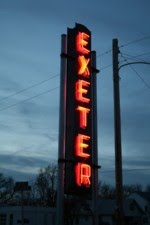The Exeter-Milligan choir performed a very moving rendition of “Beautiful Nebraska” at the 150th birthday celebration for Nebraska.
Exeter-Milligan eighth graders Jaiden Papik (left) and Daisy Kanode give their part of the Nebraska History presentation.
Above - The Exeter-Milligan eight grade class gave a presentation on the highlights of Nebraska.
Below – The Exeter-Milligan fourth graders shared the reports
they did on a famous Nebraskan at the Sesquicentennial celebration.
Above – Judy Dinneen, Exeter G.F.W.C. member (left) introduces
Exeter Postmaster Kathy Stych who shared the special U.S. postage stage that
was released for the Nebraska Sesquicentennial.
Below – The Exeter G.F.W.C. Woman’s Club honored area Veterans
for their part in keeping Nebraska safe. Here, Karen Chapman, Exeter
G.F.W.C. member, presents a gift to veteran Dwayne Luzum.
Sesquicentennial isn’t easy to pronounce but it certainly is
fun to celebrate.
The Exeter G.F.W.C. Woman’s Club made sure that this special
anniversary was not forgotten in Exeter on Wednesday, March 1.
This group of ladies planned and carried out a fabulous
celebration to honor the 150th anniversary of the statehood of
Nebraska.
After Exeter G.F.W.C. members Karen Chapman and Kathy Due
welcomed the audience the Exeter-Milligan choir was introduced and gave a brief
history of the state song, “Beautiful Nebraska,” before performing a very
moving rendition of the song.
Next on the program were the Exeter-Milligan eighth graders
from Mr. Brian Murphy’s Nebraska history class. The group had created a
power point outline of the history of Nebraska and each student told a part of
the story.
The fourth graders from Exeter-Milligan had each researched
a famous historical Nebraskan and presented several interesting facts about the
men and women they admired. Some of those the audience heard about were
astronaut Clayton Anderson, Father Ed Flanagan and koolaid inventor Edwin
Perkins.
The last group of Exeter-Milligan students to share were the
second grade. They had each drawn a picture of a distinctive Nebraska
icon, ranging from a covered wagon, to cows and Chimney Rock.
G.F.W.C. member Judy Dinneen introduced Exeter Postmaster
Kathy Stych who gave the history behind the stamp that was released specially
for Nebraska’s sesquicentennial. The stamp depicts the Sandhill Crane migration
at dawn near the Platte River in a photo by Michael Forsberg.
The audience was able to see stamp up close during the program.
During the program the Exeter G.F.W.C.
members also shared interesting facts about the state’s history. When
sharing about World War II the history of the Great Nebraska Scrap Drive of
1942 was explained. Apparently, in an effort to collect more scrap iron
for the war, Nebraska initiated a scrap drive that pitted county against
county. Fillmore county collected 273 ¾ pounds during the drive and the
efforts of Nebraska inspired a nationwide scrap drive.
Along with their discussion of war efforts
the Woman’s Club recognized the veteran’s in the audience.
The keynote speaker, Doug Rung, of Fairmont
was introduced. Rung is known throughout the county as a Nebraska and
Fillmore County historian. He shared about the trip he took in covered
wagons from Grand Island to Scottsbluff years ago. “I was the only
Nebraskan on the trip. . .we had eight wagons plus a chuckwagon . . .we had
three flour sacks, two for good clothes and one for dirty clothes and
everything modern was thrown out.”
The group rode or walked in wagons pulled by
Clydesdales and according to Rung, “we had a great menu, it was pinto beans,
pinto beans and pinto beans.”
Rung was designated the marshal and walked
behind all of the wagons to make sure no one fell out or got left behind.
“We had three quit the trip and the wagonmaster said that if it had been in the
pioneer days they would have been the ones who died on the trail.”
The group followed the Oregon Trail through
Nebraska, ate hardtack for lunch and washed their dishes in the sand. “We
washed with lye soap and had no combs. We innovated a lot of things.”
During the trip they visited one grave near
Kennesaw, that of Susan C. Haile, who died on the trail near modern day
Kennesaw. Rung shared that they learned her husband had buried her and
returned to Missouri for a marble headstone which he sold his horses to
purchase. Mr. Haile then procured a wheelbarrow to bring the headstone
back to Nebraska to mark his wife’s grave.
Other bits of history the group experienced
on the trail included a visit from a Native American who would not sell any of
his wares, but only trade. The group also received letters from their
family members via Pony Express.
After Rung presented the Woman’s Club members
thanked the many participants in the program and closed with all of the
participants singing “Happy Birthday” to Nebraska.









No comments:
Post a Comment